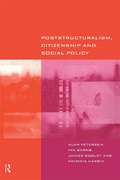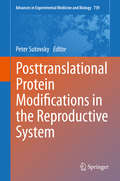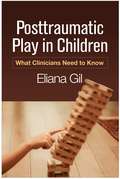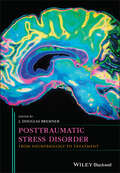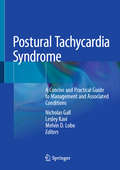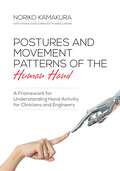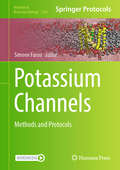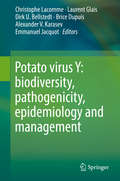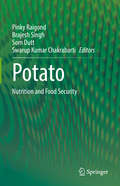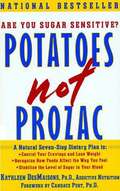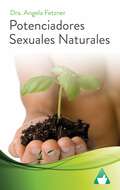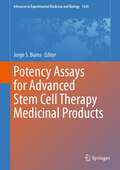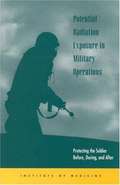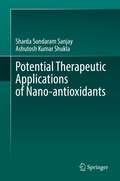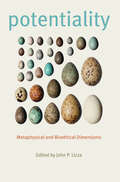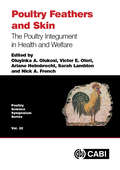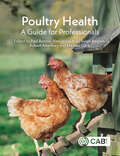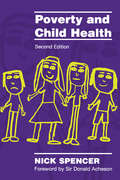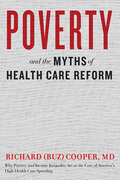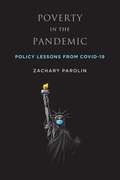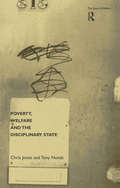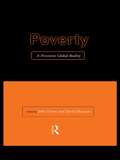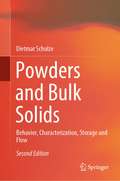- Table View
- List View
Poststructuralism, Citizenship and Social Policy
by Patricia Harris Alan Petersen Ian Barns Janice DudleyPoststructuralism, Citizenship and Social Policy shows how poststructuralist ideas can be usefully applied in the areas of welfare, health, education and science and technology policy, making particular reference to the theme of citizenship. The impact of poststructuralism on thinking in the social sciences and humanities over the last decade has been profound. However, to date, there has been little systematic analysis of the implications of poststructuralism for the critical analysis of social policy. Poststructuralism, Citizenship and Social Policy will provide essential reading for students and researchers working in the areas of welfare studies, the sociology of health and medicine, political studies, social work, social administration and education.
Posttranslational Protein Modifications in the Reproductive System
by Peter SutovskyThis book's aim is to increase the awareness of a great variety of posttranslational modifications in the male and female reproductive system. Some of the most intriguing reproductive strategies, mechanisms, and pathways involving PTM are discussed, with an added angle of evolutionary conservation and diversity. The book also chapters on sperm-egg binding, as well as on histone modification in both the embryo and sperm. Chapters are also devoted to protein ubiquitination, the regulation of sperm function during fertilization in mammals and tubulin modifications in gametes and embryos. There are no other current books on posttranslational protein modifications as they relate to reproduction, making this contribution unique in the field. It is useful for both researchers and graduate students alike.
Posttraumatic Play in Children: What Clinicians Need to Know
by Eliana GilFrom leading expert Eliana Gil, this book provides child clinicians with essential knowledge and tools for evaluating and working with posttraumatic play. Such play, which is often repetitive and disturbing, may help resolve traumatic experiences--but can also become toxic. The book guides the clinician to determine what is going on with a given child and intervene sensitively and effectively. Evocative case material is interwoven with up-to-date information on the developmental impact of trauma and ways to facilitate children's natural reparative capacities. A reproducible assessment checklist to help clinicians differentiate between useful and dangerous posttraumatic play can be downloaded and printed in a convenient 8 1/2" x 11" size.
Posttraumatic Stress Disorder: From Neurobiology to Treatment
by J. Douglas BremnerPosttraumatic Stress Disorder: From Neurobiology to Treatment presents a comprehensive look at this key neuropsychiatric disorder. The text examines the neurobiological basis of post-traumatic stress and how our understanding of the basic elements of the disease have informed and been translated into new and existing treatment options. The book begins with a section on animal models in posttraumatic stress disorder research, which has served as the basis of much of our neurobiological information. Chapters then delve into applications of the clinical neuroscience of posttraumatic stress disorder. The final part of the books explores treatments and how our basic and clinical research is now being converted into treatment. Taking a unique basic science to translational intervention approach, Posttraumatic Stress Disorder: From Neurobiology to Treatment is an invaluable resource for researchers, students and clinicians dealing with this complex disorder.
Postural Tachycardia Syndrome: A Concise and Practical Guide to Management and Associated Conditions
by Nicholas Gall Lesley Kavi Melvin D. LoboThis book describes the varying clinical manifestations of postural tachycardia syndrome (PoTS) and provides a robust yet practical set of clinical tools for those managing patients suffering with this syndrome. Guidance is provided by a range of disciplines relevant to PoTS including general and specialist assessments, associated conditions, diagnostic considerations, therapy and service models. Postural Tachycardia Syndrome: A Concise and Practical Guide to Management and Associated Conditions presents the scientific background and practical information for the busy medical professional, illustrating key features with care-based materials to help them manage this condition, which can be a challenge for patients and clinicians alike.
Postures and Movement Patterns of the Human Hand: A Framework for Understanding Hand Activity for Clinicians and Engineers
by Noriko KamakuraThink of the complexity of ordinary hand activity and how to describe it all, both precisely and concisely. The author, a noted occupational therapist in Japan, offers a disciplined approach to doing just that. Whereas research has heretofore been limited
Potassium Channels And Their Modulators: From Synthesis To Clinical Experience
by John M EvansPotassium ions K+ ions are vital in physiological processes, particularly with regard to the cardiovascular system. Modulators influence the channels through which these ions flow and the research into modulator drugs of these channels is the subject of rapidly-advancing research. This work is intended to be of use as a tool for those working in th
Potassium Channels: Methods and Protocols (Methods in Molecular Biology #2796)
by Simone FuriniK+ channels regulate the passage of potassium ions across lipid membranes, influencing numerous biological functions, including homeostasis, sensory perception, and information transmission. This volume explores the widespread involvement of K+ channels in cellular processes, which makes these membrane proteins intriguing targets for both fundamental scientific inquiry and the development of pharmaceutical compounds. The chapters in this book provide an in-depth look at various techniques and the latest protocols commonly used in ion channel research to investigate K+ channel structures, functions, and their interactions with drugs. Written in the highly successful Methods in Molecular Biology series format, chapters include introductions to their respective topics, lists of the necessary materials and reagents, step-by-step, readily reproducible laboratory protocols, and tips on troubleshooting and avoiding known pitfalls. Cutting-edge and thorough, Potassium Channels: Methods and Protocols is a valuable resource for any researcher who is interested in learning more about potassium channels. Chapters 5 and 7 are available open access under a Creative Commons Attribution 4.0 International License via link.springer.com.
Potato virus Y: biodiversity, pathogenicity, epidemiology and management
by Christophe Lacomme Laurent Glais Dirk U. Bellstedt Brice Dupuis Alexander V. Karasev Emmanuel JacquotPotato virus Y (PVY) infects a wide host range mainly within the Solanaceae and is distributed worldwide. PVY is transmitted by more than 40 aphid species in a non persistent manner. Isolates of the PVY species are highly variable at biological, serological and molecular levels. Epidemiological studies have highlighted the emergence of distinct potato PVY variants able to induce necroses on potato tubers. Due to the lack of efficient resistance to PVY isolates inducing necrotic symptoms in cultivated varieties and the plant-to-plant transmission of isolates through the daughter tubers, PVY has become the most economically important virus for the potato industry. The review offers an overview of several decades of research on PVY but also focuses on the latest data obtained by expert on PVY worldwide on the biological characteristics of PVY, interactions between aphids-hosts, its evolution and management. Identified knowledge gaps to understand further PVY biology will be discussed.
Potato: Nutrition and Food Security (Compendium Of Plant Genomes Ser.)
by Swarup Kumar Chakrabarti Pinky Raigond Brajesh Singh Som DuttThis informative book focuses on the nutritional value of potatoes and ways to improve it. With the world reeling under the burden of an ever-growing population, there is a pressing need for affordable and nutritious staples to feed the billions. Potatoes are grown in a broad range of countries around the world and can substantially contribute to future food security. Given the increasing consumption of potatoes, there is a need for a book that compiles information on and raises awareness of their nutritional value, while also encouraging their consumption. The respective chapters of this book cover the chemical composition, structure and health benefits of potatoes, as well as genetic modifications used to alter the concentration of relevant chemical compounds in them. The book provides an overview of potatoes as a nutrient-dense crop, and discusses important aspects such as the role of potatoes in human diet, how they can improve the overall health of individuals, their role in addressing malnutrition etc. Its chapters deal with topics such as carbohydrates and glycemic index, dietary fibers, vitamins, proteins, phenols, carotenoids, anthocyanins, minerals, lipids, glycoalkaloids, new health-promoting compounds, the composition and utilization of potato peel, nutritional significance of potato products, and potato probiotics. Given its scope, the book will be of interest to undergraduate students, graduate students and researchers in plant physiology and biochemistry, plant genetic engineering, the food sciences and agriculture, as well as industry partners in related fields.
Potatoes Not Prozac: A Natural Seven-Step Dietary Plan to Control Your Cravings and Lose Weight, Recognize How Foods Affect the Way You Feel, and Stabilize the Level of Sugar in Your Blood
by Kathleen DesmaisonsDr. DesMaisons believes that depression is often caused by sugar sensitivity. In this book, she offers tools to help the overeater make a determination and correct the imbalances if they are found.
Potenciadores Sexuales Naturales (Dra. Angela Fetzner #3)
by Dr Angela FetznerComo leerás en esta guía, no siempre tienen que ser las píldoras azules... Existen numerosos potenciadores sexuales a base de hierbas, suaves pero seguros, la mayoría de los cuales también actúan como afrodisíacos, es decir, estimulan adicionalmente el deseo y la libido. Este libro presenta los potenciadores sexuales a base de hierbas más conocidos y mejor estudiados. Muchos de los potenciadores sexuales a base de hierbas se conocen desde hace mucho tiempo en sus países de origen, a menudo lejanos, y su efecto de aumento de la potencia se utiliza allí desde hace mucho tiempo, pero sólo poco a poco estos potenciadores sexuales a base de hierbas están conquistando también el mercado europeo. Detrás del deseo de los potenciadores sexuales a base de hierbas, por supuesto, está también el deseo de no tener que "trabajar" el acto sexual con una píldora química, pero en el fondo llevamos el deseo de una sexualidad holística, misteriosa, única, mística. Deseamos más sensualidad, es decir, queremos disfrutar con todos nuestros sentidos. Y aquí es exactamente donde las plantas del amor pueden entrar en juego: No sólo refuerzan la potencia, sino que también despiertan todos los sentidos y pueden ayudar a reducir el estrés y a volver a relajarse adecuadamente. Si nos tomamos esto a pecho, la vida amorosa se vuelve (de nuevo) satisfactoria y misteriosa.
Potency Assays for Advanced Stem Cell Therapy Medicinal Products (Advances in Experimental Medicine and Biology #1420)
by Jorge S. BurnsThis volume of the Springer book series Advances in Experimental Medicine and Biology covers potency assays, one of the most complex yet fundamental evaluations that critically influence stem cell regenerative medicine. Developing potency assays for cell-based medicinal products comes with numerous challenges due to the highly specialised nature of the application and purpose. This book provides the reader with the knowledge necessary to understand issues governing the successful development of potency assays, highlighting an international outlook of how the various challenges raised are being managed. Stakeholders concerned with potency assay development range from patient and clinician to contract research organisations, small and medium enterprise, regulatory authorities and even politicians. The value of potency assays is poised to increase given the inevitable watershed as early-stage clinical trials addressing safety progress to trials testing efficacy. Contributors from clinical, academic, industrial and regulatory sectors establish a broad point of view for guidance and timely debate. Potency assays require extensive collaboration across disciplines and sectors, as well as compromise and the authors aim to constructively address the many key aspects involved.Potency assays provide a quantitative measure of the biological activity of advanced therapy medicinal products (ATMPs) and thus are required for their market authorization. As the pace of ATMP development accelerates, the need to develop specific, accurate, and robust potency assays for each product is also accelerating. The volume Potency Assays for Stem Cell Advanced Therapy Medicinal Products presents a broad outlook on the development, quality attributes, and implementation of potency assays for ATMPs. The first few chapters introduce a nuanced historical perspective on the science of potency assay development, describe specific quality attributes of an idealized potency assay, indicate pitfalls associated with developing such assays for ATMPs, and review guidance recommended by regulatory authorities on assay suitability for product approval. Subsequent chapters highlight efforts to develop potency assays for specific ATMPs, including skeletal stem cells, mesenchymal stromal cells, extracellular vesicles, CAR T-cells, and discuss emerging technologies/platforms for potency assay design. The volume concludes with a chapter reviewing potency assays used for the release of commercial ATMP products, which amalgamates information contained in previous chapters. Overall, the knowledge contributed from leading authorities in both academia and industry is an ideal resource for technicians, scientists, clinicians, process engineers, and regulators working with ATMPs.—Donald G. Phinney, PhD Professor, Department of Molecular Medicine, Herbert Wertheim UF Scripps Institute for Biomedical Innovation & Technology
Potential Radiation Exposure in Military Operations: Protecting the Soldier Before, During, and After
by Institute of MedicineThe Committee's final report, reiterating technical aspects addressed in a 1997 interim report, and putting the research findings in an ethical context. The report focuses on the potential exposure of military personnel to radiation doses up to 700 millisievert, examining dosimetry, radiation physics, and the medical follow-up of potential subsequent tumor development. There is no index. Annotation c. Book News, Inc. , Portland, OR (booknews. com)
Potential Therapeutic Applications of Nano-antioxidants
by Ashutosh Kumar Shukla Sharda Sundaram SanjayThis book highlights the nano-antioxidants and their potential therapeutic applications. The chapters start with basic information on free radicals and antioxidants, through natural antioxidants, mechanisms of their action, ending with the use of nano-antioxidants particularly its potential therapeutic applications. Nano-antioxidant therapy has a promising future that has to be explored. It is a bridge topic to connect the already existing literature with potential therapeutic highlights. This book is designated for students and researchers interested in Biochemistry, Chemistry, Physics, Food Science and nutrition, Pharmaceutical Science and Medicine. It would also be interesting to global audiences from human and animal nutrition to food preservation and packaging.
Potentiality: Metaphysical and Bioethical Dimensions
by John P. LizzaClassic articles and newly commissioned chapters analyze the nature of potentiality in bioethics.What is the moral status of humans lacking the potential for consciousness? The concept of potentiality often tips the scales in life-and-death medical decisions. Some argue that all human embryos have the potential to develop characteristics—such as consciousness, intellect, and will—that we normally associate with personhood. Individuals with total brain failure or in a persistent vegetative state are thought to lack the potential for consciousness or any other mental function. Or do they?In Potentiality John Lizza gathers classic articles alongside newly commissioned chapters from leading thinkers who analyze the nature of potentiality in bioethics, a concept central to a number of important debates. The contributors illustrate how considerations of potentiality and potential persons complicate the analysis of the moral consideration of persons at the beginning and end of life. A number of works explicitly uncover the Aristotelian background of the concept, while others explore philosophical issues about persons, dispositions, and possibility. The common assumption that potentiality is intrinsic to whatever has the potentiality is challenged by a relational view of persons, an extrinsic account of dispositions, and attention to how extrinsic factors affect realistic possibilities. Although potentiality has figured prominently in bioethical literature, it has not received a great deal of logical, semantic, and metaphysical analysis in contemporary philosophical literature. This collection will bring these thorny philosophical issues to the fore. Incorporating cutting-edge research on the topic of potentiality, this thought-provoking collection will interest bioethicists, philosophers, health care professionals, attorneys engaged in medical and health issues, and hospital and governmental committees who advise on policy and law concerning issues at the beginning and end of life.
Poultry Feathers and Skin: The Poultry Integument in Health and Welfare (Poultry Science Symposium Ser.)
by Christine Nicol Paul Hocking Theagarten Lingham-Soliar Steve Lister Dr Victor Olori Sunday A. Adedokun Piter Bijma Avigdor Cahaner Esther D. Ellen Rick A. Emous Denis Headon Dagmar Kappel Marinus M Krimpen Paul F McMullin Thea van Niekerk Opeyemi C Olojede Otto A Tuijl Teun VeldkampThe feathers and skin in birds are the first line of defence, but are also important in helping the bird to maintain a stable internal temperature, facilitate integral mobility and ensure successful mating in some species. For poultry, the physical conditions of feathers and skin are important barometers to assess the impact of management and ensure health and welfare. Based on the proceedings of a recent symposium, this book documents the significant developments that have been made in our understanding of the importance of the integument to poultry species. The book: . Traces the development of the integument over time and discusses our current understanding of its embryonic development. . Includes a broad range of studies covering genetics, welfare, health, nutrition, and management. . Promotes research opportunities in an under-studied field. Providing a comprehensive yet concise summary of the available research, this book is an invaluable resource for both the poultry industry and for researchers in animal science and welfare at undergraduate and graduate levels.
Poultry Feathers and Skin: The Poultry Integument in Health and Welfare (Poultry Science Symposium Series)
by Christine Nicol Paul Hocking Theagarten Lingham-Soliar Steve Lister Dr Oluyinka A Olukosi Dr Ariane Helmbrecht Dr Victor Olori Nick French Dr Sarah Lambton Sunday A. Adedokun Piter Bijma Avigdor Cahaner Esther D. Ellen Rick A. Emous Denis Headon Dagmar Kappel Marinus M Krimpen Paul F McMullin Thea van Niekerk Opeyemi C Olojede Otto A Tuijl Teun VeldkampThe feathers and skin in birds are the first line of defence, but are also important in helping the bird to maintain a stable internal temperature, facilitate integral mobility and ensure successful mating in some species. For poultry, the physical conditions of feathers and skin are important barometers to assess the impact of management and ensure health and welfare. Based on the proceedings of a recent symposium, this book documents the significant developments that have been made in our understanding of the importance of the integument to poultry species. The book: . Traces the development of the integument over time and discusses our current understanding of its embryonic development. . Includes a broad range of studies covering genetics, welfare, health, nutrition, and management. . Promotes research opportunities in an under-studied field. Providing a comprehensive yet concise summary of the available research, this book is an invaluable resource for both the poultry industry and for researchers in animal science and welfare at undergraduate and graduate levels.
Poultry Health: A Guide for Professionals
by Michael Jones Chris Morrow David Parsons Peter Cargill Scott Reid Patrick Garland Paul F McMullin Filip Van Immerseel Damer Blake Janet M Bradbury Andrew Broadbent Ian H Brown Vanessa Ceeraz Jens Peter Christensen Jane K. Cook Vivien Coward Annatachja DeGrande Fien DeMeyer Evelien Dierick Richard Ducatelle Kannan Ganapathy Evy Goosens Hafez Mohamed Hafez Rowena Hansen Rüdiger Hauck Grant Hayes Rikke Heidemann Olsen Richard Jennison Richard C. Jones Roberto LaRagione Jade Passey Androniki Psifidi Joan A. Smyth Victoria Smyth Barry Thorp Fiona Tomley Paul WigleyPoultry are a major source of valuable high-quality protein for much of the world's population, so food security is heavily dependent on maintaining poultry health. They are also increasingly important as specialist hobby animals in back-yard flocks. Despite this, veterinarians specializing in the care and health of these important domestic animals are few and far between, and many vets in small animal practice have little real experience of poultry health management and disease. Providing a comprehensive overview, this new handbook will help to plug this gap with 46 chapters of practical and accessible poultry health and management. The book: Covers the poultry industry, basic avian biology, infectious and non-infectious diseases and their agents, infection control, and disease investigation and legislation. Includes full colour images for ease of identification and diagnosis, in addition to practical guides to disease prevention. Considers areas of increasing global importance, such as antimicrobial resistance. Written by international experts, this book forms a valuable illustrated resource for veterinary professionals, veterinary students, or those entering the poultry industry.
Poverty and Child Health
by Nick SpencerThe power of purchasers exposes the weaknesses of conventional thinking on the costs and benefits of priorities. Health policy analysts now have to develop rational criteria to support decisions in a process which may be inherently intuitive. This authoritative and practical text points the way towards clear choices in resource allocation and the implications of these choices on expenditure diverted among different health care programmes.
Poverty and the Myths of Health Care Reform
by Richard (Buz) CooperProof that high health care spending is linked directly to poverty.In Poverty and the Myths of Health Care Reform, Dr. Richard (Buz) Cooper argues that US poverty and high health care spending are inextricably entwined. Our nation's health care system bears a financial burden that is greater than in any other developed country in large part because impoverished patients use more health care, driving up costs across the board.Drawing on decades of research, Dr. Cooper illuminates the geographic patterns of poverty, wealth, and health care utilization that exist across neighborhoods, regions, and states—and among countries. He chronicles the historical threads that have led to such differences, examines the approaches that have been taken to combat poverty throughout US history, and analyzes the impact that structural changes now envisioned for clinical practice are likely to have. His research reveals that ignoring the impact of low income on health care utilization while blaming rising costs on waste, inefficiency, and unnecessary care has led policy makers to reshape clinical practice in ways that impede providers who care for the poor.The first book to address the fundamental nexus that binds poverty and income inequality to soaring health care utilization and spending, Poverty and the Myths of Health Care Reform is a must-read for medical professionals, public health scholars, politicians, and anyone concerned with the heavy burden of inequality on the health of Americans.
Poverty in the Pandemic: Policy Lessons from COVID-19
by Zachary ParolinAt the close of 2019, the United States saw a record-low poverty rate. At the start of 2020, the COVID-19 pandemic threatened to upend that trend and plunge millions of Americans into poverty. However, despite the highest unemployment rate since the Great Depression, the poverty rate declined to the lowest in modern U.S. history. In Poverty in the Pandemic social policy scholar Zachary Parolin provides a data-driven account of how poverty influenced the economic, social, and health consequences of the COVID-19 pandemic in the U.S., as well as how the country’s policy response led to historically low poverty rates. Drawing on dozens of data sources ranging from debit and credit card spending, the first national databases of school and childcare center closures in the U.S., and bi-weekly Census-run surveys on well-being, Parolin finds that entering the pandemic in poverty substantially increased a person’s likelihood of experiencing negative health outcomes due to the pandemic, such as contracting and dying from COVID, as well as losing their job. Additionally, he found that students from poor families suffered the greatest learning losses as a result of school closures and the shift to distance learning during the pandemic. However, unprecedented legislative action by the U.S. government, including the passage of the Families First Coronavirus Response Act (FFCRA), the Coronavirus Aid, Relief, and Economic Security (CARES) Act, and the American Rescue Plan (ARP) helped mitigate the economic consequences of the pandemic and lifted around 18 million Americans out of poverty. Based on the success of these policies, Parolin concludes with policy suggestions that the U.S. can implement in more ‘normal’ times to improve the living conditions of low-income households after the pandemic subsides, including expanding access to Unemployment Insurance, permanently expanding the Child Tax Credit, promoting greater access to affordable, high-quality healthcare coverage, and investing more resources into the Census Bureau’s data-collection capabilities. He also details a method of producing a monthly measurement of poverty, to be used in conjunction with the traditional annual measurement, in order to better understand the intra-year volatility of poverty that many Americans experience. Poverty in the Pandemic provides the most complete account to date of the unique challenges that low-income households in the U.S. faced during the COVID-19 pandemic.
Poverty, Welfare and the Disciplinary State (The\state Of Welfare Ser.)
by Chris Jones Tony NovakA forward-looking appraisal of the welfare state which examines issues such as poverty in Britain, demonisation of the poor in areas of social policy and other related topics.
Poverty: A Persistent Global Reality
by John Dixon Professor John Dixon David MacarovThis book addresses the long-standing global issue of poverty. An introductory chapter explores concepts and definitions of poverty, the subsequent chapters providing detailed examinations of poverty in ten different countries: UK, USA, Australia, Canada, Hong Kong, Ireland, Malta, The Netherlands, The Philippines and Zimbabwe. Each chapter follows a consistent format, to facilitate comparison and focuses on the following issues:- * the socio-economic and historical context within which poverty exists * the extent and nature of poverty its causes * the measures that have been taken to mitigate it. This book will be essential reading for students of social policy and administration as well as development studies and anthropology.
Powders and Bulk Solids: Behavior, Characterization, Storage and Flow
by Dietmar SchulzeThe book concentrates on powder flow properties, their measurement and applications. These topics are explained starting from the interactions between individual particles up to the design of silos. A wide range of problems are discussed – such as flow obstructions, segregation, and vibrations. The goal is to provide a deeper understanding of the powder flow, and to show practical solutions.
